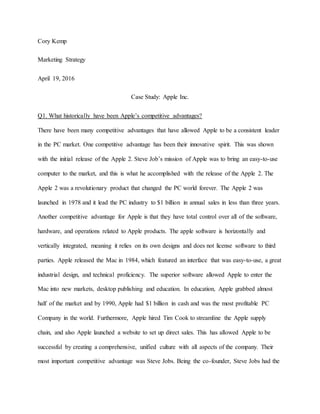
Apple Case Questions for Marketing Strategy
- 1. Cory Kemp Marketing Strategy April 19, 2016 Case Study: Apple Inc. Q1. What historically have been Apple’s competitive advantages? There have been many competitive advantages that have allowed Apple to be a consistent leader in the PC market. One competitive advantage has been their innovative spirit. This was shown with the initial release of the Apple 2. Steve Job’s mission of Apple was to bring an easy-to-use computer to the market, and this is what he accomplished with the release of the Apple 2. The Apple 2 was a revolutionary product that changed the PC world forever. The Apple 2 was launched in 1978 and it lead the PC industry to $1 billion in annual sales in less than three years. Another competitive advantage for Apple is that they have total control over all of the software, hardware, and operations related to Apple products. The apple software is horizontally and vertically integrated, meaning it relies on its own designs and does not license software to third parties. Apple released the Mac in 1984, which featured an interface that was easy-to-use, a great industrial design, and technical proficiency. The superior software allowed Apple to enter the Mac into new markets, desktop publishing and education. In education, Apple grabbed almost half of the market and by 1990, Apple had $1 billion in cash and was the most profitable PC Company in the world. Furthermore, Apple hired Tim Cook to streamline the Apple supply chain, and also Apple launched a website to set up direct sales. This has allowed Apple to be successful by creating a comprehensive, unified culture with all aspects of the company. Their most important competitive advantage was Steve Jobs. Being the co-founder, Steve Jobs had the
- 2. long-term vision of Apple and worked every day to live out the vision. Steve Jobs was forced out of 1985, but returned as the interim CEO in 1997 when the company was near bankruptcy. Jobs refocused Apple to only having 4 product categories, rather than 15 it had previously. Through Steve Job’s leadership, Apple created the iMac in 1998, which allowed Apple’s sales to outpace the industry average for the first time in many years. Steve Jobs made strategic decisions to make Apple products the most competitive by bringing a new culture to Apple, and positively changing the image and brand of Apple. Q2. Analyze the personal computer industry. Why did Apple struggle historically in PCs? It is true that Apple was the company who pioneered the personal computing devices, but IBM was the company the mainstream PC’s. This was the biggest competitor to the early success of Apple. The IBM PC operated on an “open” system that allowed producers to clone it. Another reason why Apple struggled with PCs was the price. Macintosh did have a loyal customer base which allowed them to sell it at a premium price. IBM- compatible prices started to drop, and the high Macintosh’s looked unfeasible and too expensive. Another reason for the struggle of Apple PCs was the rise of “Wintel”. “Wintel” was the combination of Windows OS and Intel Processor, and it dominated the industry. Thousands of manufacturers built PCs around building blocks from Microsoft and Intel. Nearly 90 % of all PCs in the world were ran on some version of Microsoft’s operating system by the end of 2014. This made it difficult for Apple to differentiate the Macintosh in the PC industry due to the intense competition coming from other PC manufacturers. The three top PC manufacturers were Lenovo, Hewlett-Packard, and Dell, which accounted for 51% combined. Q3. Evaluate Apple’s strategy for the Apple Watch. Has Tim Cook taken the right approach? Would you suggest any course corrections?
- 3. During the three years after the death of Steve Job, Apple seen excellent revenue growth, by iPhone and iPad sales. Tim Cook, the current Apple CEO wanted to focus on the innovativeness that Apple was started with. This was something that Apple attempted with the Apple Watch. In September 2014, Tim Cook announced the launch of the Apple Watch. From the frame of the case, I think this was the right approach as, the wearable technology market is an emerging one. I think Tim Cook is keeping the focus on the core products and using the Apple Watch as a new way to drive profits. This is similar to Steve Job’s “Digital Hub” strategy. I think for the first generation, the Apple Watch has many great features that are appealing to consumers, such as the fitness tracker and the ability to receive notifications from the iPhone straight to the wrist. I think there are some negatives to the Apple as well. The Apple Watch had to be charged each day and it only worked with newer iPhones. The watch was also expensive as well: prices start at $349 for the basic model and ranged as high as $17,000 for the 18-karat gold model. Also, there are many competitors that have already released their own versions of smartwatches, making the market rather crowded. I think one correction would be to make the watch compatible for all generations of iPhone. This will broaden the scope of customers that would be willing to buy the watch.